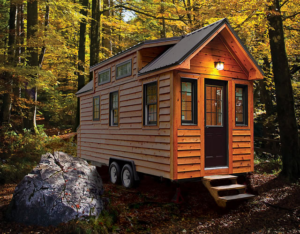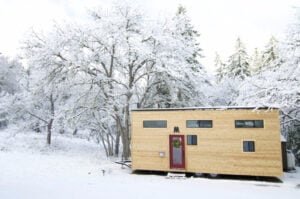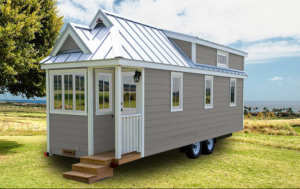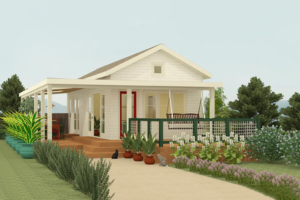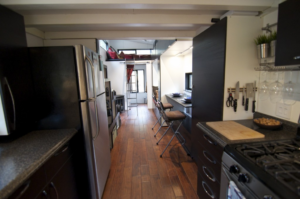The tiny house movement is growing–and not on a tiny scale. In the past four years, interest in the tiny house movement has nearly quadrupled as tracked on Google Trends. The trend is not just limited to the U.S.; tiny houses are popping up all over the world in countries like New Zealand, Canada, the Philippines, etc.
So what is the tiny house movement? You may have heard some call it a lifestyle, a social movement, or a financial savings/retirement plan. Or maybe you haven’t heard of it at all. The point of this article is to explore what is a tiny house and why people like it.
What is the Tiny House Movement?
The tiny house movement consists of, well, tiny houses; I am talking smaller than 500 sq. feet on average. So to put that in perspective, a fairly normal-sized house is around 2,500 sq. feet, a number which has exponentially grown in the past 30 years. In 1973, the average house size was 1,500 sq. feet. It is interesting that within the growing trend of larger homes, the tiny house movement has emerged. This is partly in response to the economic instability that we are facing, which includes a need for frugality and decreased spending.
The movement also encompasses the minimalist lifestyle, another growing social movement that we will talk about later on. And the environmental benefits of downsizing are numerous–less space, less utilities, less resources used. Tiny homes appeal to all sorts of people: the millennials, the retired, the frugal family. I think the appeal comes because it’s the chance to design, build, and live in your dream home in a completely economical way, and who wouldn’t want that?
The Minimalist Lifestyle
Minimalism originally is an art trend that emerged in the 1950s. Its characterizing features are large, simple forms and colors that avoid cluttered detail, as pictured on the left in a Picomodi painting. The early art trend extended to music characterized by short, repetitive phrases, and even to “less is more” architecture. What began as an artistic style ultimately became a social movement that constitutes eliminating “the unnecessary” in order to have more freedom to focus on the essential.
Many people think that minimalists only believe in giving away all of their stuff, abandoning normal interaction with society, and living either as nomads traveling the world or hermits isolated from the world. But minimalists will tell you something different; for them, “the essential” is different for everyone, whether it be to have a family and a home, or to have a successful career. The focus is on living a decluttered life that finds meaning through experiences and people rather than through possessions. But possessions aren’t the only thing minimalists look to declutter; the minimalist lifestyle seeks to declutter all aspects of your life. Its purpose is to eliminate stress and extra expenses by focusing on the here and now and what you really need, and it might be just what our consumer-oriented generation needs.
Where Can I Put a Tiny House?
You would think the answer would be pretty straightforward on this one: on your property. But even that can get a little hairy. When it comes to building or property in general, you have to make sure to check out the zoning laws of wherever your property site is. A zoning law specifies how property can be used by designating it for commercial or residential use and regulating size, structure height, etc. And right now, these specified measurements and standards are generally high, so building a legal small home is addressed specifically in only a few cities.
There are two types of tiny homes: a tiny house on wheels (aka a trailer), and an ADU (accessory dwelling unit). Different zoning laws apply to the different types and vary depending upon the state, but the general trend is that it is easier to build a tiny home with wheels and have it be passed off as a trailer which involves it being inspected as a homemade trailer and given a license plate. An ADU is more complicated because it is classified as an official dwelling place, but doesn’t meet the structure standards of most zoning laws.
The states that have the most progressive zoning laws (and are therefore more tiny-house-friendly) are as follows:
- California
- Colorado
- Florida
- Massachusetts
- Michigan
- New York
- Oregon
- Texas
If you want to know more about the states listed here and their specific restrictions, visit here. And if you didn’t see your state there, check this list by the American Tiny House Association to find information on your state’s zoning and building codes in regard to tiny homes.
How Much Does a Tiny House Cost?
If one of their claims to fame is such cost efficiency, how much does it really cost to live in a tiny home? Obviously, the cost will vary depending on whether you are building your own, whether you are renting, the size of the small house, if it’s on wheels, the number and type of appliances, etc. Here is a cost-analysis of multiple tiny home scenarios:
- Build Your Own Tiny House. On average, a tiny house requires $25,000-$35,000 in materials. This of course does not include upgraded amenities or added features, but it is much cheaper than constructing your own normal house. I am sure you have heard of tiny homes being built with $7,000 or $8,000, but the difference here would be in quality of materials, building permit fees, and manual labor. If you do the majority of the building yourself, you can save sometimes over $7,000 in the process; but that is a big chunk of time out of your schedule, and money is time as well.
- Buy An Already Made Tiny Home. Newly constructed tiny homes can be anywhere from $35,000 to $100,00 and are generally customized. The higher the price, the better material quality, better household appliances, better electricity/plumbing, etc. Or the high price could mean you are buying in a popular location, like Los Angeles for example (you’ll definitely need to find a cheap storage unit in LA). The benefits to buying an already made tiny home are that you save time in having to build, they are usually move-in ready, and you can trust a professional’s building skills a bit more than your own (I speak for myself here).
- Rent a Tiny House. The average long-term rent for a small house is about $500/month, with options as cheap (and rare) as $300/month, up to over $1000/month. As always, the issue with renting is analyzing the cost efficiency over time; sometimes it is cheaper to rent for a long period of time, especially if that means you don’t have to pay for building permits or land fees. Vacation rentals, like a tiny house AirBnB, can be up to $139 a night, so you can spend a week out in the woods or even do a test-run of small home living before deciding the lifestyle is for you.
Check here for more information on building, material, and appliance costs for a tiny house. Make sure to find energy efficient appliances that maximize your square footage; the whole point of the tiny home is to save money by downsizing and living more simply. And aim to build in such a way that you remain free of debt in your tiny homemaking process so that you can fully enjoy the blessings of your home where less is more.
Where to Find Building Plans
With the growing movement, construction groups are popping up all over the place that are specializing in tiny home building. With a variety of plans and builders, you are sure to be able to design and build the tiny house of your dreams. Check out this compiled list of tiny house designers and plan suppliers so you can get started on making your dream home.
Tiny Home Builders
They are one of the biggest names in the tiny home community. They have books, hold workshops, etc. all in the name of educating the public on what it is to live the tiny home lifestyle and how to build your own tiny home. Take a look at their plans page to see if they have one that catches your eye. Look at the photo above for an example of their Tiny Living design.
The Tiny Life
This tiny home building page is dedicated to finding simpler ways to build your tiny home. They have a compiled list of their favorite designs and plans from all over to make your selection easier. And they provide nifty tools to help you narrow your search process, using house parameters, a comparison grid, home reviews, etc. Above is an example of a plan taken from the “hOMe” designers.
Tumbleweed Tiny House Company
The great thing about this building company is their extensive plans. Each building design has a plan of over 50 pages with detailed instructions so that even a beginning builder can successfully build one of their homes. Take a look at their beautiful Cypress design.
House Plans
They have plans for all types of housing you would want to build, so of course they have included plans for the tiny home on their website. They are a trusted, reliable company that guarantees the lowest prices (kind of like the Walmart of home building). Plus they have tons and tons of plan options. Above is their plan #917-4.
Tiny House Build
They call their tiny home designs “the hOMe” and promise build-ready, engineered, professionally drawn plans for your tiny hOMe on wheels. These mobile tiny houses are decked out with modern appliances and can be set up for on or off the grid. Here is a look at the inside of one of their model designs.
So do you think the tiny home lifestyle could be for you? It might be the change you are looking for if you are feeling overwhelmed by the consumer-oriented pressures of society. Downsizing and decluttering could be a game-changer. Tiny homes are designed to simplify life by literally having less space to muddle up; save money, time, and space by truly adopting the motto “less is more.”
But along with this, recognize that the tiny home movement does not have a monopoly on living a simpler life. The concept they represent is something that we all can benefit from. Do we really use or need all that we have? Are we dedicating our time and money to what really matters? Maybe you won’t be a tiny home owner, but it’s okay to go ahead and adopt the tiny home mentality and enjoy the simple life.


